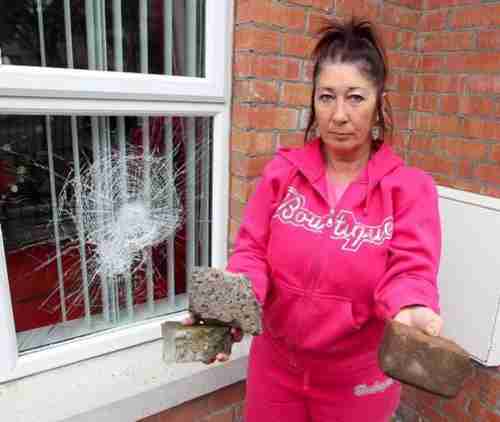Political leaders in Belfast, Ireland, are appealing for calm after violence flared with petrol bombs and other missiles thrown, according to the Belfast Telegraph.
 Belfast resident Anne-Marie Shanks beside windws which were smashed (Belfast Telegraph)
Belfast resident Anne-Marie Shanks beside windws which were smashed (Belfast Telegraph)
In the worst sectarian violence in a decade, scores of masked men launched coordinated attacks on homes and people in the Catholic pro-republican section of Belfast, resulting in several injuries.
The violence is being blamed on the Ulster Volunteer Force (UVF), a Protestant pro-loyalist militia formed in 1966 to fight the republicans in Ireland.
The violence in Northern Ireland is usually portrayed as religious in nature, where Catholics fight against Protestants.
But from the point of view of Generational Dynamics, it can be called an ethnic conflict between indigenous Gaelic Irish people (usually Catholic, republican, nationalist) versus descendants of invading English and Scottish people (usually Protestant, loyalist, unionist). As is often the case, religion is not the “cause” of this conflict, but is a tool used by the factions to rally supporters.
Generally speaking, the objective of the republicans is to unify the Republic of Ireland (southern Ireland) with Northern Ireland into a single republic, while the objection of the unionists want Northern Ireland to remain part of the United Kingdom.
Echos of the Plantation of Ulster
There have been clashes between the two groups since the 1400s, but the most important pattern of wars was set by the Nine Years War (1594-1603), where the Irish Gaelics attempted to overthrow English rule. The result was the Plantation of Ulster, which Gaelics today refer to as “ethnic cleansing,” because the British drove the Gaelic from their land, took it over as landlords, and used the Gaelics as servants.
The English Civil War of the 1640s was a generational crisis war for England, but it was an Awakening era war for the Gaelics, despite a massacre of the Gaelics by the British under Oliver Cromwell.
The next crisis war for Northern Ireland was the Williamite-Jacobite war, climaxing in a victory of the British with the Battle of the Boyne on July 12, 1690. This was the date of the victory of Protestant William of Orange over the Catholic King James II, and it followed England’s Glorious Revolution of 1688, where the Dutch Prince William “invaded” England and overthrew King James without firing a shot.
Today, sectarian violence in Northern Ireland tends to increase as July 12 approaches, as it’s commemorated by the Protestant Orange Institution and associated groups, according to CS Monitor.
The new violence has raised concerns that a new round of “The Troubles” is about to begin. In the 1960s-90s, in a period known as “the Troubles,” there was violence and terrorist attacks between the two factions, mostly ending with peace agreements in 1998 and 2005. From the point of view of Generational Dynamics, we’re seeing a familiar pattern, with alternating periods of peace and violence, with no end to the violence in sight.
COMMENTS
Please let us know if you're having issues with commenting.